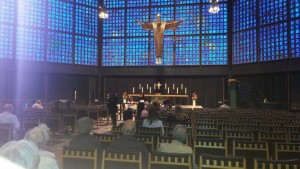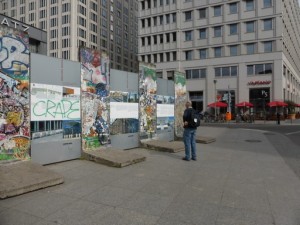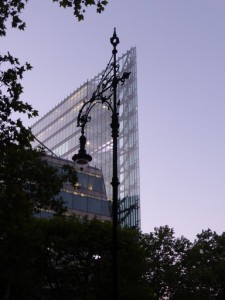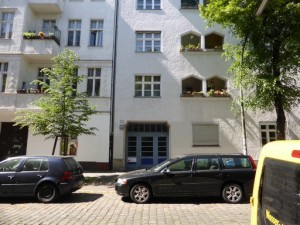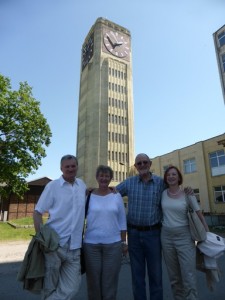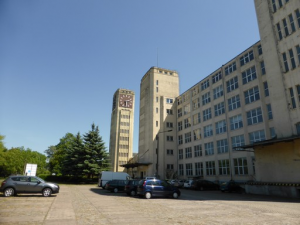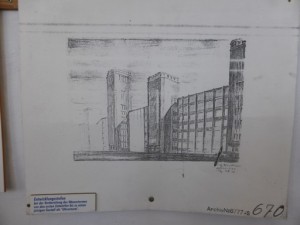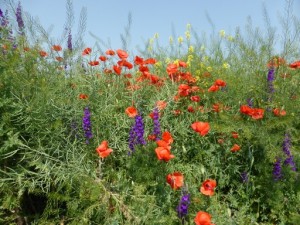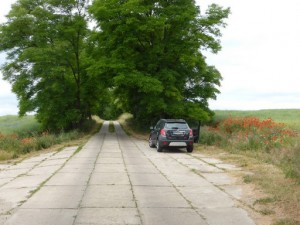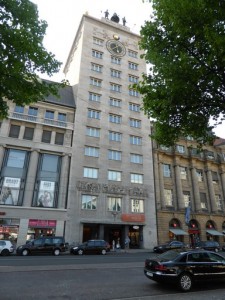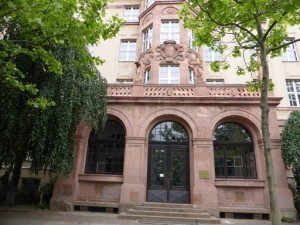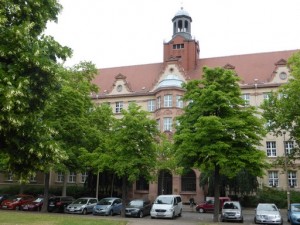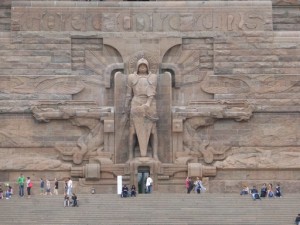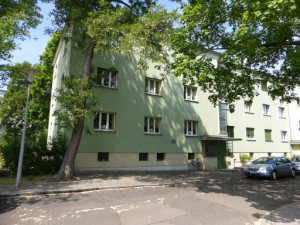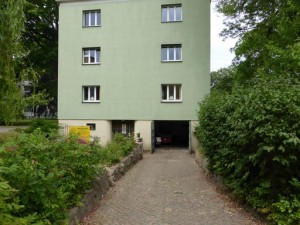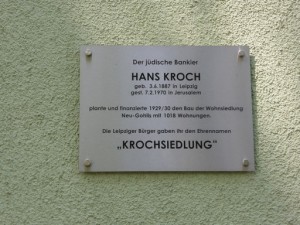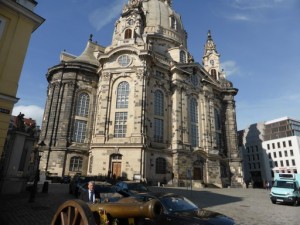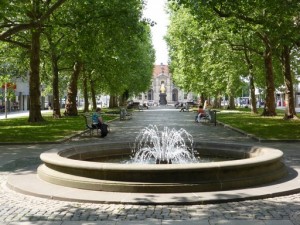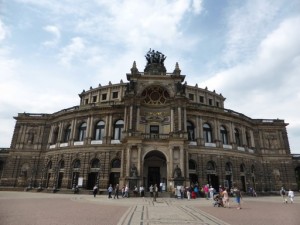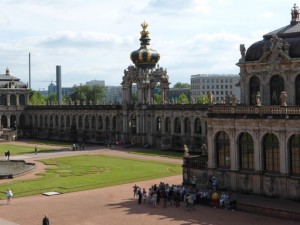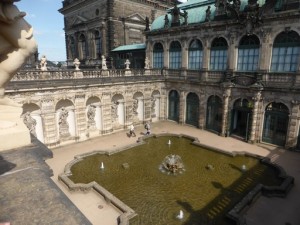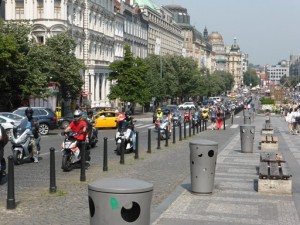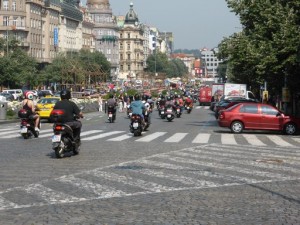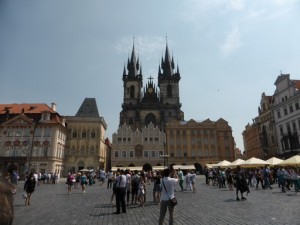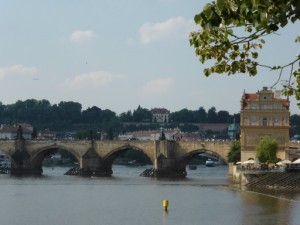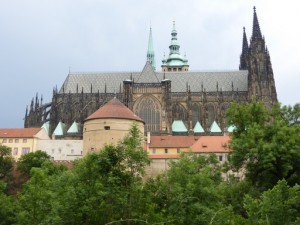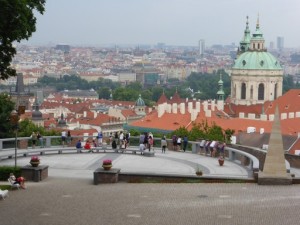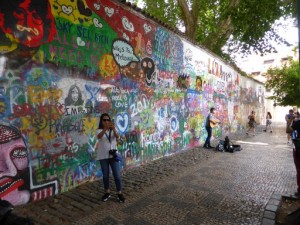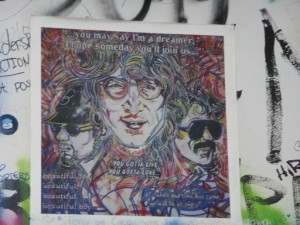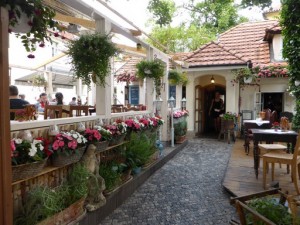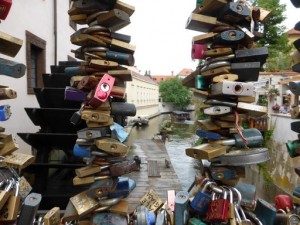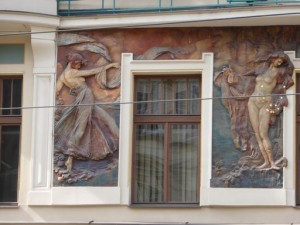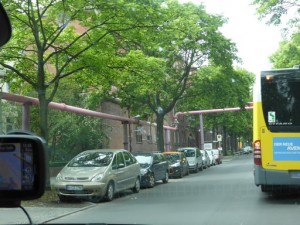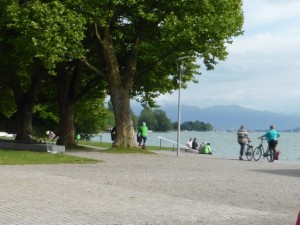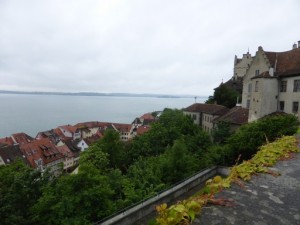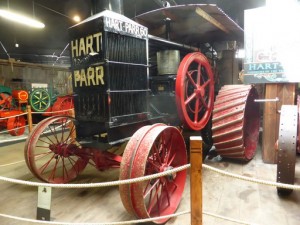…”on the train of Middelmann history…” Maryke tells the story, beginning on Tuesday 2nd June
After an uneventful flight we arrived in a very green Holland. We did not have much time between our arrival and departure for Berlin and there were two things uppermost in my mind: where can I find Zoutes and will our suitcases make the transfer in time? Both were successfully accomplished.
A taxi took us to Hotel Zoo on the Kurfuersterdamm (or Ku’dam is it is better known). It is a Design hotel and is very nicely laid out and with very nice rooms. Of course there is dimmed light everywhere to lend atmosphere. This hotel in its heyday and before refurbishing hosted the likes of Greta Garbo, Romy Schneider and all kinds of celebrities, royals and politicians. When you go up in the lift from the ground floor, flashbulbs pop in the wall of the lift as if you are being paparazi’d.
We arrived mid-afternoon and it certainly was too late for a mittag-schlaf so we went walkabout. The first thing we came across, near to the hotel, was the Wilhelm 1 Gedachnis Kirche.
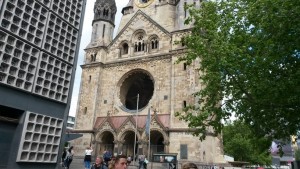
Above: The Gedachtniskirche in Berlin
The church was heavily bombed in the war and only the entrance portal remains and was restored with original mosaics as far as possible. The arched roof is very impressive and on the walls bullet holes are visible. A new bell tower is being built.
Next to the old ruin is a newly built church which is round and pretty non-descript until you go inside. The numerous blue glass panes are glorious when viewed from the inside. See above.
We mosied around in the lavish shopping street and ended up with an early pasta dinner nearby the hotel. After unpacking we had a very early night. To bed when it was still light was really weird!
Wednesday
We grabbed a bite to eat around the corner. It is just a bit too extravagant to have a R270 breakfast in the hotel. The local bakery serves fresh fruit, croissants, filled rolls and darn good coffee. Then we hopped on the Hop-on-Hop-off bus to take in the major sights of the city. What a wonderful invention that is, as it certainly saves a lot of foot-slogging.
Our first stop was the Potsdammerplatz where we hopped off to see the Film Museum, after all Berlin was and is the film capital of Germany, on par with the Cannes film festival. The first hall was mirror after mirror into infinity with famous stars, of which we knew quite a few. It was quite something, this seemingly elevated walkway with stars floating around you. Robert sneaked a photo although he wasn’t supposed to. The rest was old film history, documents, photos, film cuts – most interesting. A main feature of course was Greta Garbo, her outfits were on display with film cuts showing her wearing such outfits and also those of Marlene Dietrich. Nazi war films were of course propagandist and one was about Ohm Paul Kruger which they biased against England. Yes they spelt it “Ohm”. A very worthwhile visit.
Above: Robert inspecting the remains of the Berlin Wall which forms a display with explanatory text at Potsdammerplatz near the Film Museum
Above: The old and the new – Berlin skyline from Ku’dam
We hopped on again and our next stop was Checkpoint Charlie, where I went through in 1970 when Berlin was still divided. This was on my first visit to Europe since leaving Holland aged 9, and I could speak no German and we were of course completely indoctrinated against Communism, so I was a bit jittery on my own. There was barbed wire then and now it is open and a photographic opportunity for which privilege you pay Euro 2.00 Large pieces of the wall are still to be seen, as well as a restored area of how the “safe zone” (to prevent escape to the West) was laid out on the Russian side.
It is interesting that wherever the Wall used to be in Berlin there is a double cobblestone track, to remind the people of the past ills of humanity. As if that will stop those who are intent on war!
From there we went to the Berlin Dom (cathedral) which is huge and lovely inside, but very grimy outside. Very ornate with a huge highly decorated cupola. Took lots of photos, and listened to a violin, a viola and a cello practising some pretty heavy music. Then down to the dungeon to inspect some old kings and queen’s caskets (as fast as we could walk) and out via the cathedral shop.
Next door is a huge museum with a large grassy area filled with many young people. We soon realised that this was because of the Humbolt University next door.
Next the bus took us to the Brandenburg gate. The place was quite chaotic due to the fact that they were in the process of setting up a fan-site for the upcoming UEFA soccer final on Saturday. Therefore the photos were not great either. Then we walked to the Reichstag (parliament building) which is quite impressive. There are so many beautiful buildings it is surprising they survived the war.
Then we walked for a fair distance “Unter den Linden” the original carriage lane from the King’s palace to his hunting ground. The famous Berlin Zoo is situated in this forest. We walked towards the river Spree where boats full of tourists were going back and forth, until we reached Bellevue House, home of the German President. From there the bus took us back to the Ku’dam where we treated ourselves to coffee and kuchen at Café Kranzler, a famous old establishment where Walter took us in 1970. It was much nicer and classier then with nice white table cloths and pretty curtains. Now it is not all that special, although the coffee and cake is still good!
Thursday
Today we took the underground to Rathaus Neukoeln station, the nearest to Weserstrasse which was an investment by grandfather Paul Middelmann.
Confiscated by the state after WWII, Walter who kept the necessary documents could prove ownership and got a tidy sum which was shared between him, Hans and Gertie when Germany was reunified. The area looks like it has been recently upgraded, with many buildings have been repainted recently, although there is also evidence of graffiti on older buildings. We were lucky, the Supervisor was at work, and let us in so we could inspect the very nice back garden of the block of flats. We took quite a lot of photos of the area, which seems on the up and up in some ways.
In the afternoon Robert went to look at tjorries at a museum Nick had told him about, while I walked the shops. Thus we were both happy. Then we went out together for a meal and a further walkabout, followed by some home admin and updating the report.
Friday
I did the packing and Robert fetched the rental car, an Opel Mokka with all the modern bells and whistles, which took him considerably longer than anticipated. We drove 160 km from Berlin to Wittenberge. Ruth’s stepfather, Felix Ascher the architect, designed the famous Singer sewing machine factory there. We had been in contact with Lothar and Sigrid Wuttke who were trying to find out more about him, so we thought to pay the place a visit. The Wuttke’s both worked at Singer/Veritas sewing machine factory for 20 years until it was closed in 1992. At its peak it employed 3200 personnel and manufactured 450,000 machines per year. Lothar is in charge of archives of the company. They are very nice people and made us feel very welcome and special. They had organised pictures and an interview with the local press. They were quite upset that we didn’t get the parcel they left for us at the Hotel. They will have it sent to Kressbronn. Ons sal sien! The visit to the Singer factory in the previous DDR was quite an eye-opener.
Interesting facts
Felix Ascher, Granny Ruth’s stepfather, designed the first reinforced concrete building in Germany based on an original Singer building concept. He had to fit in with the English system, and had to metricate all dimensions. He designed the big water tower which still contains the largest clock in Europe (only Big Ben is bigger).
The first three floors of the tower are dedicated as a museum. He connected the buildings via underground tunnels to move raw material used for the making of the sewing machines from one part of the factory to the next. The underground tunnels served as bomb shelters during the war.
Above: Felix Ascher’s signature is just below the right side of the drawing
(Singer became Veritas meaning “truth”). They had various makes including Bernina under their wing. The English warned the Allies not to bomb the factory as it had USA shareholding! There were about nine processes just for the making of the sewing needles.
Most of the factory buildings are now empty, but there is a still a school and training college using the old office building. An ex staff member runs a spares department that send sewing machine spares all over the world and some logistics firm and a few other businesses utilize parts of the factory building.
We also visited the local museum which also had lots of old Singer history on display together with old history of the village of Wittenberge. This featured photos of the destruction of the famous bridge by the Germans to stop the Americans from crossing. Mr. Hertz who built an oil factory in the mid 1800’s persuaded the German Kaiser to route the railway line from Berlin to Hamburg via Wittenberg, which was actually a bit of a dog-leg. The oil factory (linseed, rape seed oil etc. and later coconut and other products) was situated on the Elbe for transport purposes. The Singer factory was built in Wittenberge in 1926 because of the excellent transport links.
The lady in charge of the Museum was very nice and kept us interested. She later joined us for tea at the water’s edge of the Elbe-river. For me it was a bit of a strain as I had to concentrate quite hard on the German, but I didn’t have to ask too many questions. It also got quite hot (30 degrees). Remind us to tell you about the fridge dating back to the early 1900’s.
We were booked into a nice country hotel, called the Eichen-krug (Oak tankard) who served a gourmet meal of fabulous smoked ham with fresh white asparagus.
Saturday: Leipzig
It was a nice journey through the country-side. This seems to be the breadbasket, with wheat everywhere. Here and there big patches of cornflowers and purple flowers I did not know, interspersed with bright red poppies.
We arrived at the hotel just before 3pm. Well situated on the edge of the inner/old city opposite a huge railway station. I thought it might be a bit boring here as weekends most places are closed – well what a surprise to find the place humming with people and food stalls of every description throughout the whole of the old part of the city. Every block with a band stand with different music and every man and his dog and all his children were out and about. I expect that with the football UEFA finals tonight it will be noisy!
And so we walked the place flat with the help of a map and found first of all the Kroch Bank building we had heard so much about from Walter. Kroch, the banker, had built New Gohlis where grandfather Paul Middelmann was the Director in charge and where the family lived. The Kroch bank was confiscated by Hitler and the Kroch family fled Europe. Mr. Kroch died in Jerusalem at age 83.
Hans did his bank traineeship at Kroch Bank from 1932 to 1936 and during this period travelled quite extensively in Europe, from Scandinavia to Spain. His training gave him the opportunity to start work in Cape Town at Inter-Union Finance.
Above: Kroch bank, the first high rise building in Leipzig
It was noisy alright with lots of shouting all night long. Fortunately once we closed the window there was blessed silence.
The Hop-on Hop-off bus took us to all kinds of interesting places. First stop near the Zoo and gardens, in South Gohlis where Schiller (poet) used to live in a little place. Some rich guy built himself a summer house there, commonly known as the Palace, now open to the public with a restaurant attached. The neighbourhood seems really nice and I would like to see more.
We hopped off to find the Leibnizschule where Walter and Hans matriculated. Lovely old place on the Nordplatz (north square). Took some photos and waited for the bus to pick us up again, then we hopped off at a lovely little area on the Elster river where the old warehouses have been converted to flats, very picturesque. One of the buildings contained the first ever mail order business in the world. From there we walked to the next stop through the park and picked up again at the Music quarters (college, university etc.)
We passed a state funded (DDR) sport school where teacher training was done and top athletes were trained to excel for the Fatherland – all 13,000 of them!
Above and below: Leibniz schule (school)
Below: Volkerschlacht-denkmal 91 Meters high – this place is huge!! (Monument to the battle of Nations)
We changed to a different line at the Volkerschlacht-denkmal . This commemorates a war against Napoleon in 1813 where 60,000 Hungarians, Russians, Swedes and Prussians perished fighting against Napoleon at Leipzig. At 91 meters high and with more than 500 steps to the top, I decided to sit this one out and just looked around. It looks very similar to the Voortrekker Monument, and the reflection pool looks quite a bit like the one in Washington.
The next Monday the Volkerschlachtdenkmal it was the answer to the question on “Who wants to be a Millionaire” for Euro 500,000 – damn it, I wish I had been in the chair!
Then the bus to us South to the lake area where we saw an artificial canoe race course. It looks like good training for the Orange river rapids. Then a bit further there was a beach area with pleasure boats and tour boats and a New Zealand designed adventure course. Again some travel through the country side and back to town, where the festivities continued at pace.
We were told that Leipzig is built on a big marsh area and that if there is a lot of rain, the cellars fill with water and therefore every house has a proper pump to keep the cellar dry. The area in and around Leipzig is quite flat, so that doesn’t help drainage either.
We walked to the other side of the inner city and found the Leipzicher Algemeine Versicherung building where Walter had worked. On the square we found a very nice antique book store, lots of antique shops and a huge Italian restaurant. On the way back around the corner we heard some lovely music and there was the Leipzig Opera performing with orchestra and all, and some very good singing, both classic and popular (comic opera) much to the appreciation of the crowd.
It is so weird that it’s still light at 9.30. We don’t seem to be able to get to bed much before 11.
We were platvoet geloop so we had a rest in the afternoon and watched the marathon French Open tennis final. What a slog!
Monday 8th
Today we are off to Gohlis situated in the northern part of Leipzig to find the old family flat in Neu-Gohlis built by Kroch Bank on the Helgolanderweg number 7.
We found an aerial photo in Walter’s papers which we had with us. With the help of Rosy (Tom-Tom) we found the place easily enough. And there it was: Helgolanderweg, Neu Gohlis! The local population still call it the Kroch Siedlung. Neu-Gohlis, its real name is virtually unknown to anyone.
The old military base is still just down the road. During the war, the Jews were chased out of the flats and military people were put in their place.
Above: Side main entrance
Below: Side of the building where Herr Director had the only garage in the whole of the development.
On the side of the building a plaque was erected commemorating Dr. Kroch and his vision of what is now known as the “Kroch Siedlung”.
What was the Middelmann flat is now occupied by a physio-therapist and the offices of the Siedlung which consists of 1018 units. This is what Paul Emil Middelmann was in charge of. We were given some photocopies of the Paul Middelmann wohnung (apartment) featuring Walter and Hans’ room and Paul’s study. The originals had been donated by Walter on a previous visit there. The documents we still had on the Siedlung (settlement) were sent to Frau Janish who was Kroch’s secretary and who had become a friend of Gertie’s. These documents are now in the Stadtsmuseum in Leipzig.
We were introduced to Dr. Seidel who lived in house #3 (two doors down). He has lived there for 60 years and of course met Walter and Hans when they came to Leipzig for a special school reunion. He showed us around an unrestored flat, which they have kept as a museum of sorts where those people who run the history of the place have meetings. Bath with hot and cold running water, toilet and heating unit in the bathroom, heating unit in the lounge, and also hot water and a porcelain sink in the kitchen – all brand new developments at the time.
For the rest of the day we wandered around Gohlis a bit and then returned to the hotel to investigate the city centre some more, but this time on the other side where we had not yet been. We found an underground cellar converted to a smart restaurant we had been looking for, dating back to 1350 or so! Leipzig as a city turned 1000 years this year! Then it started to rain and of course our umbrella was in the hotel. Fortunately it wasn’t too heavy, but it gave us another opportunity to put our nose into another big modern shopping centre.
After a disappointing Chinese/Japanese dinner of sorts we returned to the hotel to watch Gunther Jauch (Who wants to be a Millionaire) on TV. All this gadding around is quite tiring. I must mention that we have never seen as many weird creatures as here in Leipzig – youngsters trying to be hip but turning out to be hideous, badly dressed, awful hair and tattoos and piercings all over. There is also a group of about 6 young people with 1 dog that sit between the hotel and the station is a small garden. They do nothing, drink beer and no doubt just talk rubbish all day. They probably live off the dole, so they meet early and somehow manage to look after themselves.
Tuesday 9th
We took to the road again, this time off to Dresden. We stopped at Albrechtsburg, a small village on top of a hill, featuring a huge church dating back to about 1270, overlooking Meissen, famous for (very expensive) porcelain. We took a funicular to the top – not as keen to walk as we were at the beginning of the trip, leave alone climbing a steep hill. The church was magnificent and reminded us very much of the book “Pillars of the Earth”. Just to see how all the hand-hewn pillars fit together, the erection of this church was a major achievement. We drove via country roads, all green, with wheat fields interspersed with forests.
Dresden is situated on the Elbe River, originating in Czech Rep. and running all the way to Hamburg – the longest river in Germany we were told. We again bought a ticket for the H0HO bus and took a quick tour around – the tickets are valid for the whole of tomorrow, to just get a quick lay of the land. Amazingly many of the old buildings have been restored with as much of the original material as could be rescued from the rubble after the fire bombing in February 1945. Really amazing, and there are so many that we will be hard-pressed to decide what to see and what to give a miss in the time we have available.
Above: The Frauenkirche was rebuilt costing the princely sum of Euro 180 million, of which 2/3 was donated by private enterprise (the major foundations of the world I would imagine). The dark blocks are the original ones retrieved from the rubble and the light ones newly made during the restoration.
Over dinner that night we drank a toast to Gertie who had survived the fire storm resulting from the bombing of Dresden.
Wednesday 10th
Richard’s birthday. Cheers! Finished another load of washing. We have an apartment-hotel with a washing machine! The stuff we washed last night is dry already. We walked around, finding some coffee etc and then visited the transport museum of which the most interesting was the locomotives, a bit like the railway yard in George, just smaller. Then we took the HOHO bus again to visit some places we had seen on our recce travel yesterday, amongst which the molkerei (dairy) a most ornate place selling milk products, including soaps. What is most attractive is the tiling which earned them the accolade of the most beautiful dairy on the planet, according to the Guiness Book of Records.
Getting back we moseyed around various places and got back to our large apartment, where I promptly fell asleep before going out for dinner. We followed dinner with a nice walk along the promenade above the river and boy, what a difference between yesterday’s cold and damp – tonight everyone was sitting around the square having drinks and/or dinner.
Thursday 11th
This morning took a walk through the Frauenkirche, most amazing place and incredible how it was restored to all its former glory.
Thereafter walked across the Augustus Bruecke to the north side and along a very beautiful wide, tree flanked, pedestrian shopping precinct. Some very nice shops, not the usual stuff. Beautiful old linen and silver for instance. Back over the bridge and a quick cuppa coffee at a little place overlooking the river, and then we went off to see the Zwinger complex and then the Semper Opera where we took a proper tour.
Semper designed the original building which burnt down and it was rebuilt long before it was bombed down in the war. By some miracle the original drawings of the building were found in the basement of the Archives in Berlin, and later even details of the drawings that decorated the archways and interior. Pillars were handmade and painted to look like marble, a process that takes up to 6 depths of sandpapering after hand-mixing paints and then painstakingly applying the paint. Downstairs the sandstone walls were painted to look like oak! Really!!
They decided that as most of the damage was because of wood in the interior burning, they wanted to use as little wood as possible. The interior of the opera house is a bit reminiscent of pictures I’ve seen of the opera house in Vienna. All kinds of nice tricks like shell forms above the stalls for acoustic purposes. The singers do not use mikes of any description as the acoustics are so good.
Finding out that there was a performance of Die Fledermaus by Strauss, we went for tickets only to be told that they were only seat left in the royal box. So we sat in the Royal Box for a fabulous performance, very much modernised and amazingly funny even if some of the Sachsen humour was right over our heads. What a great finish to our Dresden visit.
Above: Zwinger – Palace and now museums
AboveL Inner Courtyard of one corner
Friday 12th
After packing we hopped back into the car and headed for Prague, missing the highway of course. Czech language is completely incomprehensible but most young people speak some English or German. We continued along very much the same sort of landscape as before, but here some other crops too. I noticed fields of white poppies being grown, but only a few were open and I couldn’t get close enough to take a picture. Maybe they are being grown for cut flowers or seed.
Thank goodness the Tom-Tom found the hotel, which is an ancient Brewery where we got a beer as welcome drink! After parking the car and unpacking in our loft room on the 3rd floor (lift only to the 2nd floor) we went for a long walk across the Charles bridge and through packed shopping streets. What it’s like in July heaven only knows! On every corner there is a beautiful building. The St. Francis church on our side of the river is very decorative but with very dark frescoes. It’s pretty hot (30 degrees) today.
Tomorrow we are taking the grand tour: An English guided walking, tram and boat tour for about 6 hours to get some insights into this place.
Saturday 13th
After a leisurely breakfast in a part of the 300 seater Brauereikeller we walked to Wenceslas Square for the start of our tour. We went walking down past many buildings to the old market square. There was a strange Rubics Cube type of face churning around in a square nearby, fascinating. Vast numbers of people were walking around, sitting at many eateries, beer establishments etc. We were initially 14 folks, 9 Americans and 3 Aussies plus our guide. We could not start immediately because there was a parade of hundreds of scooters (Vespas and all other possible makes) which churned up and down the square. Many tour groups like ours, Segway tours, and so on. This city of 2.5 million is a real tourist paradise!
Above and below: Up and down the long city roads, a mad procession of scooters
Above: Beautiful city square
Above: The famous Charles bridge
Our group made our way to the Old City square which was packed with people and there was not really much time to linger before inspecting a statue of a woman giving birth (I kid you not) and then walking through the old Jewish area, which has largely disappeared as it was a small area housing far too many people and had become a real ghetto. There were a few buildings that have been restored nicely and a few nice antique shops in the area, clocks, jewellery etc. Then onto a 1 hour river cruise, after which we had a typical poor quality tourist group lunch. After lunch the 32 degree heat was broken by a thunder storm. When the rain let up a bit we moved over the famous Charles bridge and then by tram up the hill to Prague castle and cathedral.
The American girls in our small group were keen to see the owls and raptors and were, at a fee, allowed to hold them. We could only visit certain sections of the church as the rest is closed to the public. Apart from all the splendour, highlights of the castle were the fabulous view of the City and the stories told by the guide:
When two noblemen were thrown from the window of the castle, for some misdemeanour, they fell into a pile of cow manure and survived and ran away. When they returned many years later and were reinstated after they told the story that the Virgin Mary and the Angels had carried them away. This would of course have been believed in the early 1400’s.
All statues and paintings depict both men and women in a favourable light. Charles’ statue in the old city square for instance features a tall bearded, thin man, whereas in real life he was apparently squat and hairless, but if you wanted to survive, you made people look good, or you run the risk of loosing your head. We were told that the Hapsburgs were an ugly lot because of many centuries of in-breeding.
Old King Wenzeslas was apparently neither good, nor a King, only a prince. He murdered his older brother and three years later had his late brother elevated to Sainthood – kings had the power to do that in those days. Now of course the Pope has to approve such matters. According to our guide that is how families solved their problems in those days!
Above: The famous church on the hill
…… and below: the equally famous view
Our guide Blanca was absolutely non-religious and also not very complimentary about the Czech leaders. She reckons the country has been invaded by Israel, France, Russia and others and therefore their language is a mixture of all of them. They were originally Celts who were invaded by the Germanics and Huns.
That ended the tour at 4 pm and we were left to our own devices to find our way home by public transport. There is a fairly good tram, subway and bus system which costs 4 Euro for 24 hours irrespective of distance travelled. Tickets are available at any tobacconist or small mini market.
Sunday 14th
We walked to the old market at 10am to be there before the vast crowds move in and enjoyed a Cappuccino at a restaurant with a good view of the square. Then wandered past various shops near the old Jewish quarter to the river. From there we took a tram to the end station at the old and in somewhat poor condition 1894 exhibition centre. Thereafter back to the castle side of the river where we wandered along various narrow streets and came across a very long wall painted with sayings and artistic pictures, where a musician was singing John Lennon songs and playing the guitar.
Above: A long wall with well done graffiti
Above: A very small detailed portion on the wall
Above: Such a nice looking restaurant on a small river – of course we did!
Above: Lover’s locks on the bridge next to the restaurant
Above: Detail on one of the beautiful buildings
Above: (Afterthought) Water supply in overhead pipes everywhere Berlin
Just beyond that we found a delightful and small restaurant along a canal which sports a large water wheel. We decided to have lunch there. On the bridge couples have locked their engraved locks to commemorate a special day. It is well filled. Apparently the revival of this old love-tradition from Serbia was started up in Europe again a few years ago, and on the Pont des Arts in Paris it is now forbidden as the bridge was collapsing under the 40 tons of additional weight!
Nearby we found the John Lennon Pub and later a Maltese church. After a further walk along the river we took a tram again to the end of the line and back again. After a while we passed many blocks of nondescript flats where I guess the average folks live.
Today was not as hot as before! So, we walked some more and wandered onto a small island in the river where boats of all types can be rented, where people formed long q’s for the privilege. We took a rest on the grass before returning to the hotel.
Monday 15th
We checked out of hotel, said goodbye to Prague and hit the road north back to Germany via a tiny bit of Poland. Just over the Polish border we stopped for coffee in the delightful dorp of Loebau. An amazing number of beautifully decorated buildings surprised us. West Germany certainly spent a lot of money on the East!
As before we passed green wheat and canola fields, forests and green as far as the eye can see. In this part of former DDR place names and street signs are in German and Czech and further north German and Polish because the border moved back and forth depending who was in power in years gone by.
Our overnight destination was Cottbus a university town where we found a very nice “Waldhotel” next to a pine forest on the north side of the town. We had a pleasant dinner and wine on the terrace outside the dining room.
Tuesday 16th
After a similarly good breakfast we hit the road northwards towards Frankfurt a. d. Oder which once we reached it 90km later proved to be a disappointment. This large town on the river Oder close to the Polish border lacked character, no decent old town centre that we could find and lots of Stalin/DDR era nondescript buildings and blocks of flats.
We stopped at the small town of Fuerstenwalde for lunch but it had no character compared to Loebau yesterday. After ignoring Rosie’s repeated instructions to drive to Berlin we landed up on a really minor single lane cement strip road (almost like the old Rhodesian ones) where there were regular wider “lay-byes” to wait for oncoming traffic. The area is full of lakes which have the same height as the road – so no wonder when it rains a bit more than usual everything gets flooded. The early summer scene is really nice, very green, lots of fields in full bloom, be it wheat, peas, baby sunflowers in the making or other vegetables. All beautifully manicured with natural forests as a backdrop.
Then back to Berlin where we drove through areas we had not been before to reach the Holiday Inn West about 4km from Tegel airport where we leave early tomorrow morning to fly to Friedrichshafen. There is a huge park opposite the hotel, so after spending so much time in the car today, it was good to stretch our legs. It got pretty cold again, so we warmed our innards with some goulash soup for me and a ginormous hamburger (in Berlin) for Robert.
The plane trip took us over Lake Constance and into Friedrichshafen and a short taxi ride to the flat. It was far colder than expected, so we unpacked and did what we usually do around the place. Ate lots of cherries which are in the middle of their harvest right now.
On the 21st (Russel and Karen’s birthdays) we were awoken on the dot of midnight by an almighty racket. I thought the next world war had started. It was fireworks celebrating the summer solstice!
Above: Now we’ve seen Kressbronn in all seasons!
Above: The prettiest town on Lake Constance, Meersburg
Then we prepared for our trip to Lech (see separate report). Meanwhile the parcel from Berlin arrived, with more pamphlets and details about Veritas and a little Berlin Bear which stayed (temporarily) behind.
After returning from Lech we sat around and relaxed and toured around the Bodensee. We paid our pilgrimage to Max & Moritz, with Uncle and his wife and a friend. We found some statistics on the lake:
Distance around the lake 274 km
Surface 536 sq. km
Depth (deepest point) 254 m
Max length 63 km
Max width 14 km
The lake was completely frozen over in 1785, 1830, 1880 and 1963 (so much for global change being something new!)
In searing heat we drove the Bentley to Meersburg from where we took the ferry to Konstanz and around another peninsula to Radolfzell and inland to Uhldingen-Muhlhofen to visit the Tractor Museum. It was a complete surprise to find not an old barn with some tractors, but a large modern building housing tractors of all kinds of descriptions, with small side rooms depicting workshops, a school room, an old kitchen and more. There was a display of the earliest kind of hayfork to the modern one still in use. This museum is worth a visit if you every get into that part of the world. It is pretty reminiscent of the wonderful Louman car museum near Den Haag.
They also have a huge indoor/outdoor restaurant with quite a nice view. From there we headed for Marktdorf to evade the traffic around Friedrichshafen. It was a good choice.
The last few days were a trial. A heatwave descended over Germany. Not a leaf stirred and the most we could do was to take a regular dip in the lake. We drove to the lake because it was too hot to walk! The temperature of the lake increased by nearly 2 degrees per day – how that is possible on such a large body of water is beyond me. We dined at farms about Kressbron, sitting in the shade of a tree watching the sun go down at about 9pm. We slept with the all doors open until we packed and left in order to come home to a Cape Winter.
